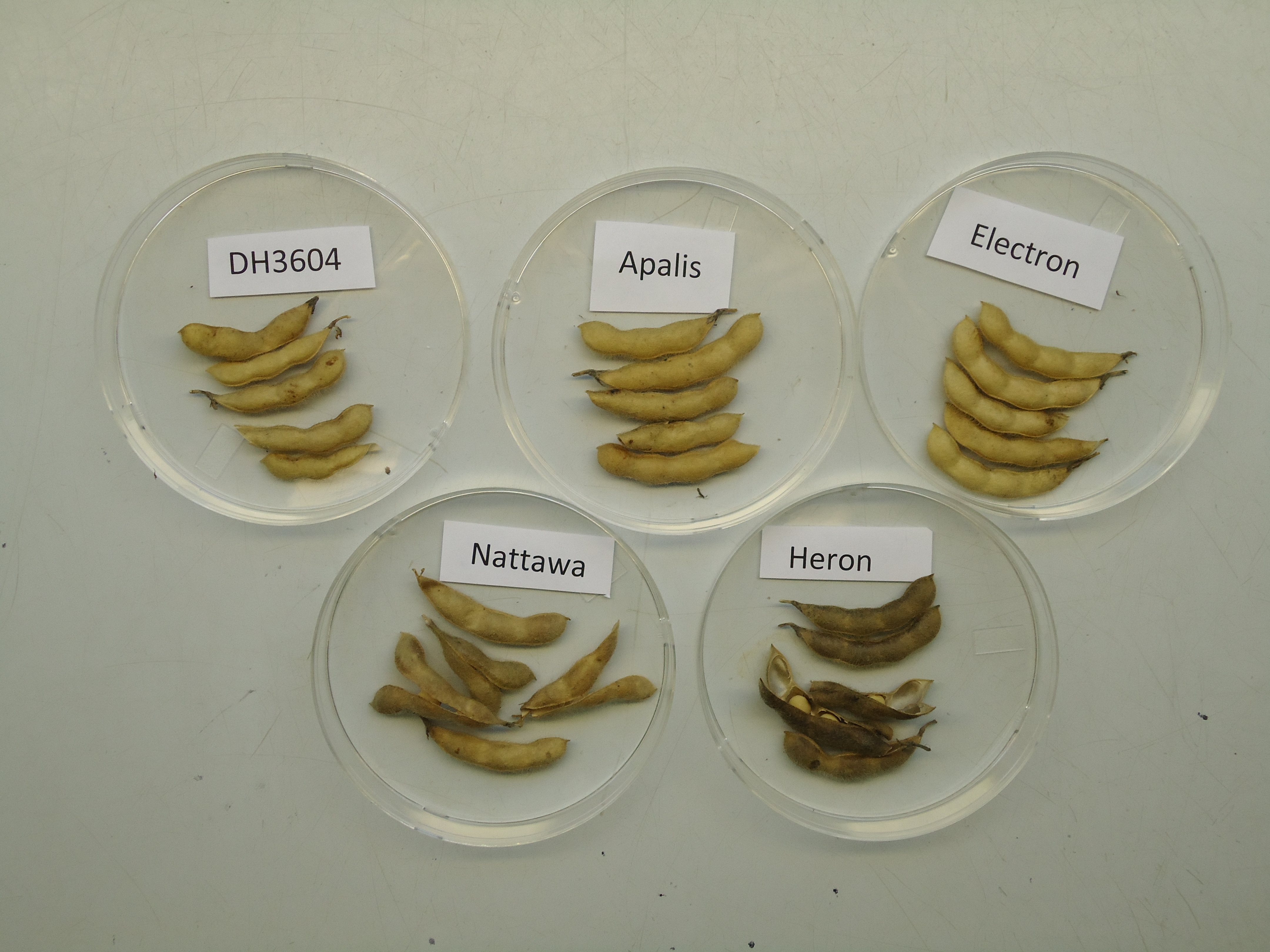Apalis
| Denomination: | 'Apalis' |
|---|---|
| Previously Proposed Denomination: | 'OT06-22' |
| Botanical Name: | Glycine max |
| Applicant/Holder: |
Agriculture & Agri-Food Canada, Ottawa Ottawa Research and Development Centre Room 1093A - 960 Carling Avenue Ottawa, Ontario K1A 0C6 Canada |
| Breeder: |
Elroy Cober, Agriculture & Agri-Food Canada, Ottawa, Ontario |
| Agent in Canada: |
Agriculture & Agri-Food Canada Office of Intellectual Property and Commercialization c/o Shannon Whyte 107 Science Place Saskatoon, Saskatchewan S7N 0X2 Canada Tel: (204) 999-9887 |
| Application Date: | 2009-05-01 |
| Application Number: | 09-6642 |
| Grant of Rights Date: | 2013-07-11 |
| Certificate Number: | 4569 |
| Date rights surrendered: | 2021-04-29 |
Variety Description
Varieties used for comparison: 'DH3604', 'Nattawa', 'Heron' and 'Electron'
Summary: 'Apalis' has anthocyanin colouration of the hypocotyl while 'Electron' does not. The lateral leaflet of 'Apalis' is lanceolate shaped while it is pointed ovate for 'Nattawa'. 'Apalis' has a violet coloured flower while it is white for 'Electron'. The pod of 'Apalis' is tan coloured while it is brown for 'Nattawa' and 'Heron'. 'Apalis' matures later than the reference varieties. The protein content of the seed of 'Apalis' is higher than 'Heron' but lower than 'Nattawa' and 'Electron'. 'Apalis' has a higher sugar content of the seed than 'Nattawa'. The 100 seed weight of 'Apalis' is higher than the reference varieties.
Description:
HYPOCOTYL: anthocyanin colouration present
PLANT: semi-determinate growth type, grey hairs on middle third of main stem, late time of flowering, late maturity
LEAF: lanceolate shaped lateral leaflet
FLOWER: violet
POD: tan
SEED: small, spherical flattened shape, yellow ground colour of testa, yellow hilum
QUALITY CHARACTERISTICS: 45.7% protein, 17.8% oil, 12.6% sugar
Origin & Breeding History: 'Apalis' (experimental designation OT06-22 and X4677-S-S-105) originated from the cross DH3604/3/(X3702-B-B-45-4) X 1677-47-B-1/X947-24-B-B-B-55(X2647-15-2-3)/2/Hartz. The final cross occurred in February 2000 in Ottawa, Ontario. The population was advanced using single seed descent to the F4 generation. The F4 population was grown in a field in 2001. Selected F5 progeny rows were harvested in bulk in 2002 and used for further testing. OT06-22 was tested at Ottawa and Nepean in 2003 and 2004. It was tested in multiple location trials since 2005. Selection criteria included seed size, adaptability and agronomic characteristics.
Tests & Trials: Trials were conducted during the 2010 and 2011 growing seasons at the Agriculture Agri-Food Canada, Eastern Cereal and Oilseeds Research Centre in Ottawa, Ontario. Plots consisted of 4 rows with a row length of 5 meters and a row spacing of 40cm. There were 4 replicates.
Comparison tables for 'Apalis' with reference varieties 'DH3604', 'Nattawa', 'Heron' and 'Electron'
Days to maturity
| 'Apalis' | 'DH3604' | 'Nattawa' | 'Heron' | 'Electron' | |
|---|---|---|---|---|---|
| mean | 124 | 119 | 116 | 120 | 118 |
Protein content of the seed (%)
| 'Apalis' | 'DH3604' | 'Nattawa' | 'Heron' | 'Electron' | |
|---|---|---|---|---|---|
| mean | 45.7 | 46.0 | 47.7 | 42.6 | 48.0 |
Oil content of the seed (%)
| 'Apalis' | 'DH3604' | 'Nattawa' | 'Heron' | 'Electron' | |
|---|---|---|---|---|---|
| mean | 17.8 | 17.5 | 17.3 | 19.9 | 17.4 |
Sugar content of the seed (%)
| 'Apalis' | 'DH3604' | 'Nattawa' | 'Heron' | 'Electron' | |
|---|---|---|---|---|---|
| mean | 12.6 | 12.3 | 10.9 | 12.4 | 11.7 |
100 seed weight (mature seed at 13-15% moisture) (grams)
| 'Apalis' | 'DH3604' | 'Nattawa' | 'Heron' | 'Electron' | |
|---|---|---|---|---|---|
| mean | 11.3 | 9.4 | 9.7 | 9.3 | 10.1 |
Click on image for larger view

Soybean: 'Apalis' (top centre) with reference varieties 'DH3604' (top left), 'Electron' (top right), 'Nattawa' (bottom left) and 'Heron' (bottom right)
- Date modified: